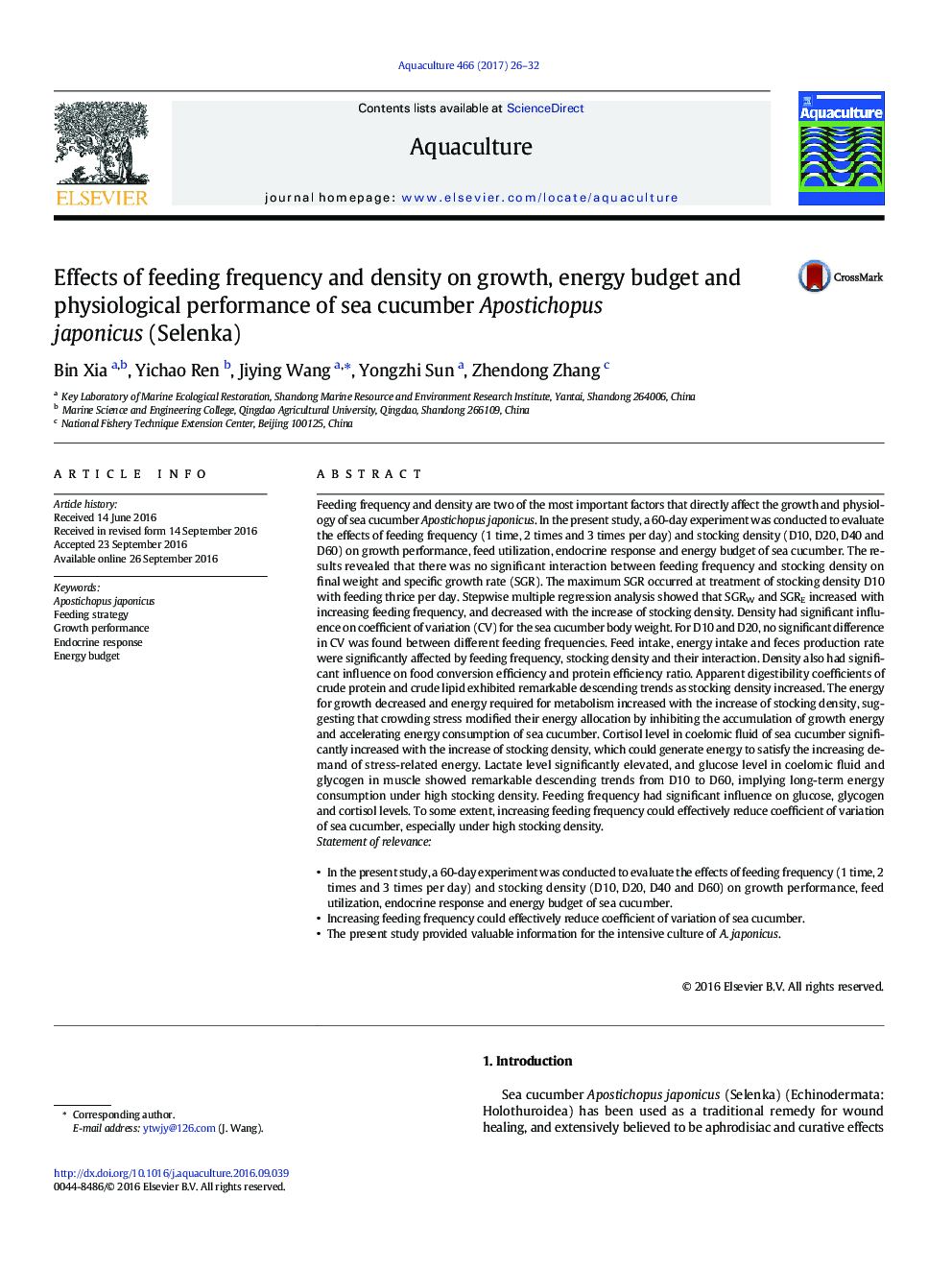| کد مقاله | کد نشریه | سال انتشار | مقاله انگلیسی | نسخه تمام متن |
|---|---|---|---|---|
| 5539170 | 1552821 | 2017 | 7 صفحه PDF | دانلود رایگان |

- Effects of feeding frequency and density on growth and physiology of sea cucumber was evaluated.
- Density had significantly influence on growth, feed utilization, endocrine response and energy budget.
- Increasing feeding frequency could effectively reduce coefficient of variation.
- This study provided valuable information for the intensive culture of A. japonicus.
Feeding frequency and density are two of the most important factors that directly affect the growth and physiology of sea cucumber Apostichopus japonicus. In the present study, a 60-day experiment was conducted to evaluate the effects of feeding frequency (1 time, 2 times and 3 times per day) and stocking density (D10, D20, D40 and D60) on growth performance, feed utilization, endocrine response and energy budget of sea cucumber. The results revealed that there was no significant interaction between feeding frequency and stocking density on final weight and specific growth rate (SGR). The maximum SGR occurred at treatment of stocking density D10 with feeding thrice per day. Stepwise multiple regression analysis showed that SGRW and SGRE increased with increasing feeding frequency, and decreased with the increase of stocking density. Density had significant influence on coefficient of variation (CV) for the sea cucumber body weight. For D10 and D20, no significant difference in CV was found between different feeding frequencies. Feed intake, energy intake and feces production rate were significantly affected by feeding frequency, stocking density and their interaction. Density also had significant influence on food conversion efficiency and protein efficiency ratio. Apparent digestibility coefficients of crude protein and crude lipid exhibited remarkable descending trends as stocking density increased. The energy for growth decreased and energy required for metabolism increased with the increase of stocking density, suggesting that crowding stress modified their energy allocation by inhibiting the accumulation of growth energy and accelerating energy consumption of sea cucumber. Cortisol level in coelomic fluid of sea cucumber significantly increased with the increase of stocking density, which could generate energy to satisfy the increasing demand of stress-related energy. Lactate level significantly elevated, and glucose level in coelomic fluid and glycogen in muscle showed remarkable descending trends from D10 to D60, implying long-term energy consumption under high stocking density. Feeding frequency had significant influence on glucose, glycogen and cortisol levels. To some extent, increasing feeding frequency could effectively reduce coefficient of variation of sea cucumber, especially under high stocking density.Statement of relevance
- In the present study, a 60-day experiment was conducted to evaluate the effects of feeding frequency (1 time, 2 times and 3 times per day) and stocking density (D10, D20, D40 and D60) on growth performance, feed utilization, endocrine response and energy budget of sea cucumber.
- Increasing feeding frequency could effectively reduce coefficient of variation of sea cucumber.
- The present study provided valuable information for the intensive culture of A. japonicus.
Journal: Aquaculture - Volume 466, 1 January 2017, Pages 26-32